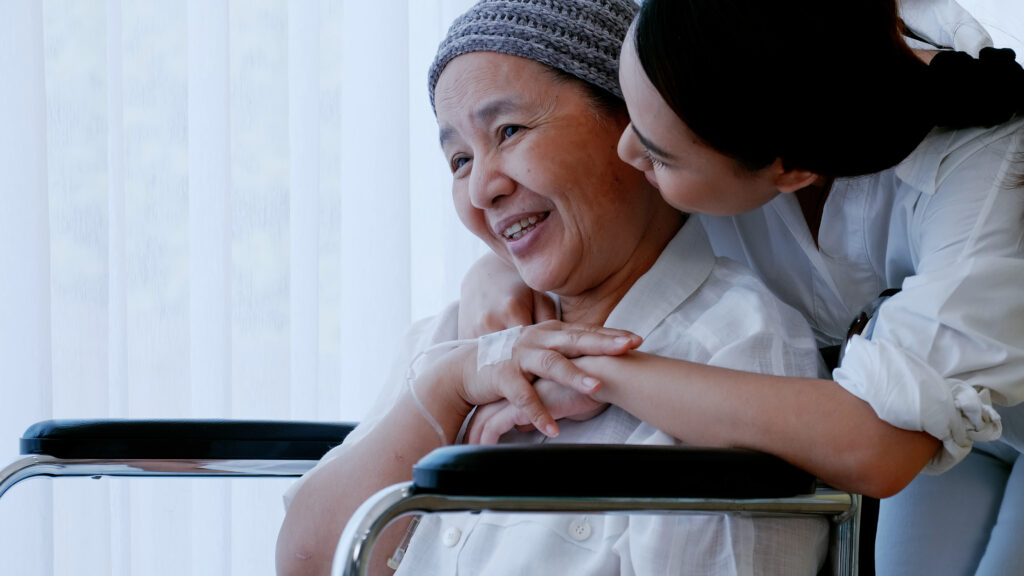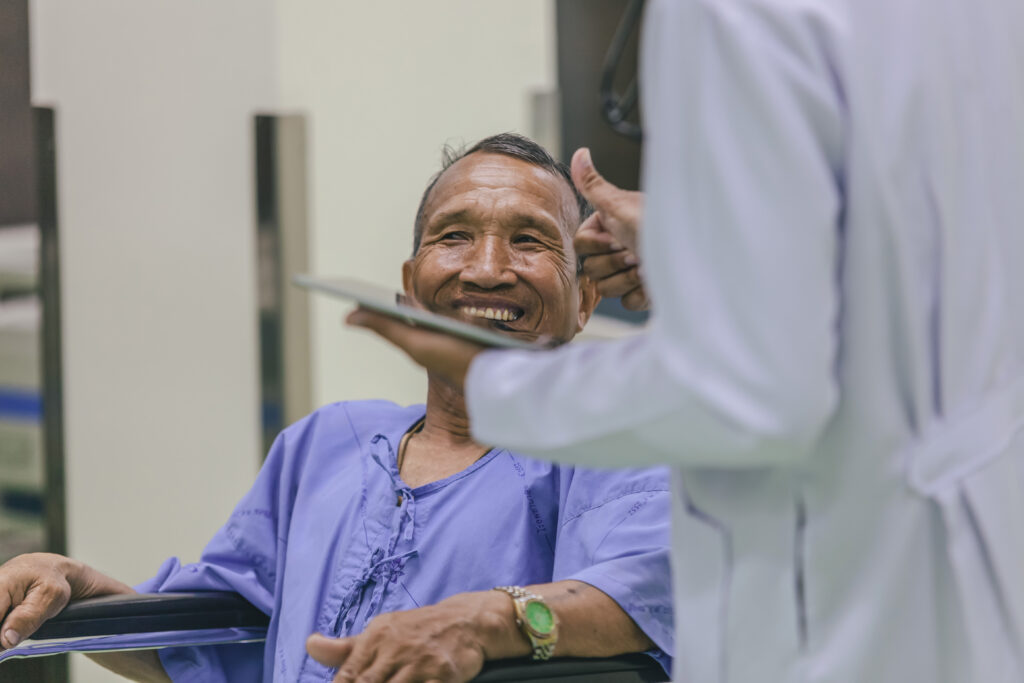A cancer diagnosis can feel overwhelming—not just for the person diagnosed but for their loved ones and caregivers too. There’s a lot to process, including understanding treatment options, managing side effects, handling emotions and finding the right support system. Whether you’ve just been diagnosed or you’re helping a loved one through treatment, it’s important to remember that you’re not alone.

Understanding your diagnosis
When you’re first diagnosed, it’s normal to have questions. Knowing more about your diagnosis can help you, your family and your care team make informed treatment decisions.
Make a list of questions you have for your doctor. Here’s a start:
- What type of cancer do I have?
- What stage is my cancer, and what does that mean?
- What are my treatment options, and what do you recommend?
- What side effects could I have during treatment?
- What support is available for me and my family?
A cancer’s stage refers to how large the tumor is and if it has spread.1 Doctors use many methods to find out the stage of cancer. This helps guide treatment decisions. For most cancers, the stages are as follows:
- Stage 0: Abnormal cells are found but haven’t spread.1
- Stages I, II or III: Cancer is present. A higher stage generally means a larger tumor or wider spread.1
- Stage IV: The cancer has spread to other areas of the body (metastasized).1
The more information your care team has, the better they can tailor a treatment plan that meets your needs and gives you the best support. You’re not facing this alone. Your doctors, loved ones and support network are here to help.
Maya’s story: A life-changing preventive care journey.
Maya’s journey shows the life-saving potential of preventive care screenings. Her story inspires us all to take charge of our health—because life’s best moments depend on it.
Understanding your treatment options
Your care team will recommend a plan tailored to your needs. They’ll consider factors such as cancer type, stage, your overall health and personal preferences. Some people may have a single treatment. Others may need a combination of therapies for the best outcome.

Common treatment types:

Surgery
Removes tumors or affected tissue2

Chemotherapy
Uses intravenous (IV), oral, injected or topical medication to target cancer cells2

Radiation therapy
Targets cancer cells with high-energy rays, such as X-rays2

Immunotherapy
Boosts your immune system to fight cancer2

Hormone therapy
Blocks or lowers hormones that fuel certain types of cancer growth2

Targeted therapy
Uses medication to focus on specific changes in cancer cells2
Each treatment has its own potential benefits and side effects. Your doctor will walk you through your options. They’ll answer your questions and help you feel informed and empowered. Bringing a trusted friend or family member to your appointments to help take notes and ask questions can help you feel more in control.
What to expect during treatment
Cancer treatment looks different for everyone. Knowing what to expect can help you feel more prepared. Here are a few things to keep in mind:3

Your treatment plan may change.
Doctors may change your care based on how your body reacts.

Side effects vary.
Some treatments may cause fatigue, nausea or hair loss, while others have milder effects. Your care team can help you handle symptoms.

Support is key.
Lean on family, friends and support groups for emotional and practical help. Whether it’s a ride to an appointment or just someone to talk to, having a strong support system can make all the difference.
No matter where you are in your journey, it’s okay to ask questions, express concerns and advocate for your needs. Your background, family history and personal health experiences all play a role in your care. Let your doctor know what matters most to you so they can help tailor a treatment plan that works for your life.

Coping with side effects
Side effects can be different for each person and depend on the type of treatment received. Here are some common ones and ways to manage them.3
Fatigue
Rest and listen to your body. Consider walking or swimming to boost energy if your doctor gives you the okay.
Nausea
Take anti-nausea medications recommended by your doctor. Also, drink plenty of water, and try having a light meal before your treatment.
Appetite changes
Your hunger may come and go during treatment. Staying nourished is essential for supporting your body. Eating nutrient-dense snacks and being well hydrated will help you feel your best.
Hair loss
Chemotherapy and radiation can cause hair loss, which may lead to physical and emotional discomfort. Some people choose to wear wigs, scarves or hats, while others leave their head bare. Do what makes you feel most comfortable. For some treatments, a cold cap can be used to reduce hair loss. Talk to your doctor about your options.
Emotional well-being
Your mental well-being is just as important as your physical health when managing cancer. Seek counseling, join a support group, journal, exercise to the extent you’re able or talk with a loved one. Finding ways to process your emotions can help you feel stronger.
Your medical team can help manage side effects with medications, therapies and lifestyle adjustments. Open communication with your doctor is vital to make sure you get the support you need.

You don’t have to face your diagnosis alone.
Across cultures, health is often a family matter and having a strong support system can make all the difference during cancer treatment. Whether it’s family, friends or a group of people who understand what you’re going through, you don’t have to do this alone.
Support groups
Connecting with others who are facing similar challenges can provide encouragement, advice and emotional support. Many groups are available in person or online.4
Patient advocates
Some hospitals offer patient advocates to help arrange care, explain medical information and connect you with resources.5
Mental health support
Counseling or therapy can help you process emotions, reduce stress and develop coping methods.
Financial help programs
If you’re worried about medical costs, there may be nonprofit organizations, hospital programs or insurance resources that can help.6
Whatever you may be feeling, know that you’re not alone. It’s normal to go through a wide range of emotions, and there are people who care about you who are ready to support you every step of the way.
The role of loved ones and caregivers
If you’re supporting someone going through cancer treatment, your presence is invaluable. Here’s how you can help:7
Offer practical support.
Help with meals, rides to appointments or household tasks.
Be a listening ear.
Sometimes, just being there to listen without giving solutions can be comforting. Keeping them company during treatments and appointments can also make a big difference.
Encourage self-care.
Remind your loved one to rest, eat well and take care of their emotional health.
Take care of yourself too.
Supporting someone with cancer can be challenging. Make sure to seek your own support when needed.

Life after treatment
Completing treatment is a major milestone, but it’s also the start of a new chapter. It’s normal to have mixed emotions. You may feel relief, joy and even anxiety about what comes next. Here are some things to think about:8
Talk openly with family and friends.
Do your best to express your needs. Let loved ones know how they can support you.
Mark this new chapter.
A small celebration or personal reflection can help you acknowledge your journey, find closure and look ahead.
Address lingering concerns.
It’s natural to worry about the future. Support groups, counseling and regular follow-ups with your doctor can help ease anxiety and keep you on track.
Give yourself grace. This journey hasn’t been easy, but you’ve shown incredible strength along the way. Your care team, loved ones and community are here to support you as you move forward.
Resources and tools
Ready to make the next step in your health journey? Your future needs you, and a healthier tomorrow starts with the actions you take now. Explore these tools to maintain your health, prevent illness and lower health care costs.
Use personalized tools
Access health information anytime, anywhere.
Download the myCigna App:

This information is for educational purposes only. It is not medical advice. Always consult your doctor for appropriate examinations, treatment, testing and care recommendations. Any third-party content is the responsibility of such third party. Cigna Healthcare® does not endorse or guarantee the accuracy of any third-party content and is not responsible for such content. Your access to and use of this content is at your sole risk.
Cigna Healthcare products and services are provided exclusively by or through operating subsidiaries of The Cigna Group.
- Cigna Healthcare. “Cancer Staging and Grading.” Knowledge Center. Last reviewed October 25, 2024. https://www.cigna.com/knowledge-center/hw/cancer-staging-and-grading-abn1258
- Mayo Clinic. “Cancer Treatment.” July 26, 2024. https://www.mayoclinic.org/tests-procedures/cancer-treatment/about/pac-20393344
- Cigna Healthcare. “Cancer Support: Coping With Cancer Treatments.” Knowledge Center. Last reviewed October 25, 2024. https://www.cigna.com/knowledge-center/hw/cancer-support-abo0892
- Cigna Healthcare. “Cancer Support: Finding Out That You Have Cancer.” Knowledge Center. Last reviewed October 25, 2024. https://www.cigna.com/knowledge-center/hw/cancer-support-abn3008
- Cigna Healthcare. “Patient advocate.” Knowledge Center. Last reviewed April 30, 2024. https://www.cigna.com/knowledge-center/hw/patient-advocate-ug5178
- American Cancer Society. “Programs and Resources to Help With Cancer-related Expenses.” Last revised December 20, 2023. https://www.cancer.org/cancer/financial-insurance-matters/managing-health-insurance/programs-and-resources-to-help-with-cancer-related-expenses.html
- Cigna Healthcare. “Informal Caregivers in Cancer (PDQ®): Supportive care – Patient Information [NCI].” Knowledge Center. Last revised March 25, 2024. https://www.cigna.com/knowledge-center/hw/medical-topics/informal-caregivers-in-cancer-ncicdr0000682690
- Cigna Healthcare. “Cancer Support: Life After Treatment.” Last reviewed October 25, 2024. https://www.cigna.com/knowledge-center/hw/cancer-support-abo1063